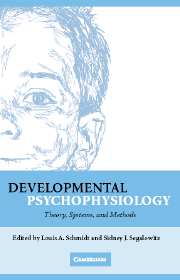Book contents
- Frontmatter
- Contents
- Foreword by Stephen W. Porges
- Preface
- Acknowledgments
- Contributors
- 1 Capturing the Dynamic Endophenotype: A Developmental Psychophysiological Manifesto
- SECTION ONE CENTRAL SYSTEM: THEORY, METHODS, AND MEASURES
- 2 Event-Related Brain Oscillations in Normal Development
- 3 Event-Related Potential (ERP) Measures in Auditory Development Research
- 4 Event-Related Potential (ERP) Measures in Visual Development Research
- 5 Electrophysiological Measures in Research on Social and Emotional Development
- 6 The Use of the Electroencephalogram in Research on Cognitive Development
- SECTION TWO AUTONOMIC AND PERIPHERAL SYSTEMS: THEORY, METHODS, AND MEASURES
- SECTION THREE NEUROENDOCRINE SYSTEM: THEORY, METHODS, AND MEASURES
- SECTION FOUR DATA ACQUISITION, REDUCTION, ANALYSIS, AND INTERPRETATION: CONSIDERATIONS AND CAVEATS
- Index
- References
3 - Event-Related Potential (ERP) Measures in Auditory Development Research
from SECTION ONE - CENTRAL SYSTEM: THEORY, METHODS, AND MEASURES
Published online by Cambridge University Press: 27 July 2009
- Frontmatter
- Contents
- Foreword by Stephen W. Porges
- Preface
- Acknowledgments
- Contributors
- 1 Capturing the Dynamic Endophenotype: A Developmental Psychophysiological Manifesto
- SECTION ONE CENTRAL SYSTEM: THEORY, METHODS, AND MEASURES
- 2 Event-Related Brain Oscillations in Normal Development
- 3 Event-Related Potential (ERP) Measures in Auditory Development Research
- 4 Event-Related Potential (ERP) Measures in Visual Development Research
- 5 Electrophysiological Measures in Research on Social and Emotional Development
- 6 The Use of the Electroencephalogram in Research on Cognitive Development
- SECTION TWO AUTONOMIC AND PERIPHERAL SYSTEMS: THEORY, METHODS, AND MEASURES
- SECTION THREE NEUROENDOCRINE SYSTEM: THEORY, METHODS, AND MEASURES
- SECTION FOUR DATA ACQUISITION, REDUCTION, ANALYSIS, AND INTERPRETATION: CONSIDERATIONS AND CAVEATS
- Index
- References
Summary
INTRODUCTION
Between birth and 2 years of age, the human cortex undergoes tremendous development, with region-specific and layer-specific patterns of synaptic maturation, overgrowth, and pruning that are undoubtedly influenced by environmental input and complex patterns of neurotransmitter expression (e.g., Huttenlocher & Dabholkar, 1997; Moore & Guan, 2001). During this period, the newborn, who is totally dependent on caregivers for survival, turns into a walking, talking, thinking, self-aware being. These anatomical and functional changes across development should be reflected in vivo in the electrical brain activity that can be measured at the scalp.
In practice, collecting data from infants can be rather difficult. While studies that condition a behavioral response, such as sucking or looking, are probably the most advanced of the techniques available, there remain considerable problems in the type and amount of data that can be collected from preverbal infants with short attention spans and immature motor response systems, especially in the first months after birth. Postmortem studies of brain development can also be problematic because death in infancy is usually associated with abnormalities that may invalidate generalizations to normal development. Many of the imaging techniques available for the study of adult brain responses are difficult to apply to human infants. For example, fMRI and MEG require that the subject remain very still throughout the testing period. It is thus possible to test sleeping infants, but rather difficult to test awake infants (Anderson et al., 2001; Hattori et al., 2001; Souweidane et al., 1999).
Information
- Type
- Chapter
- Information
- Developmental PsychophysiologyTheory, Systems, and Methods, pp. 69 - 102Publisher: Cambridge University PressPrint publication year: 2007
References
Accessibility standard: Unknown
Why this information is here
This section outlines the accessibility features of this content - including support for screen readers, full keyboard navigation and high-contrast display options. This may not be relevant for you.Accessibility Information
- 5
- Cited by
